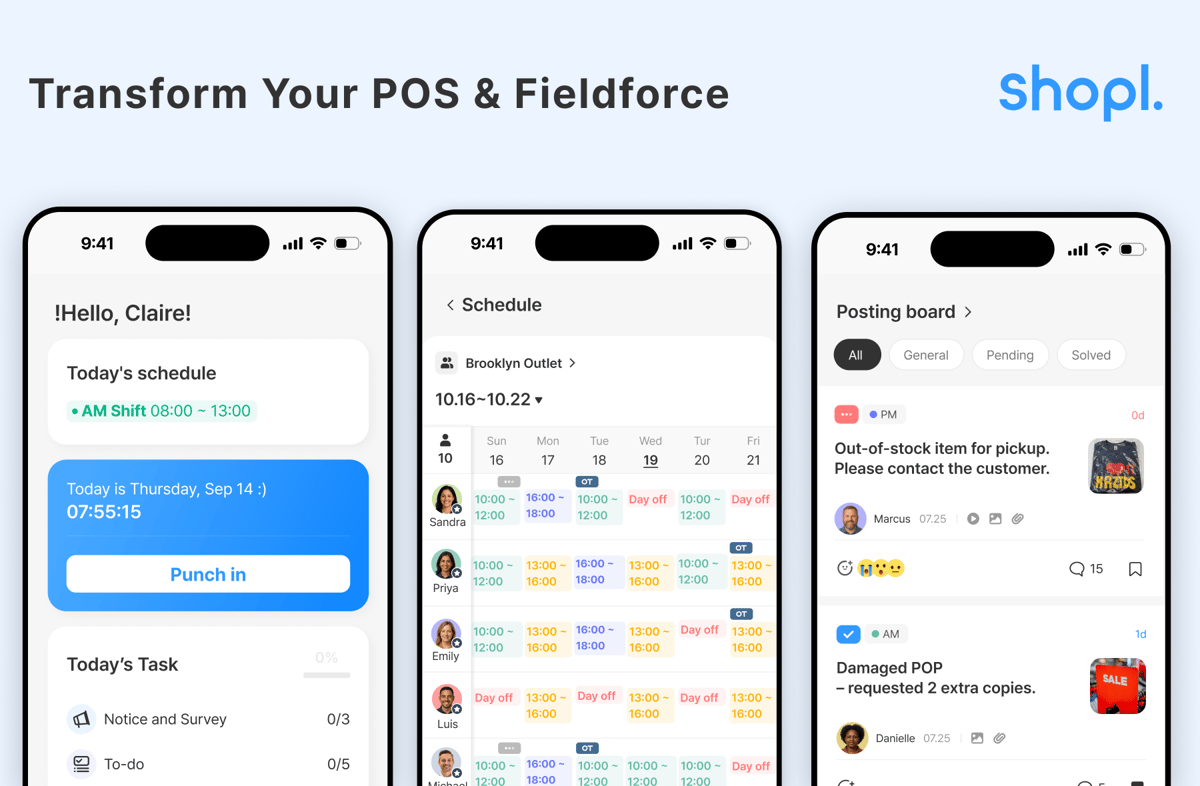Fashion Store Guide, Part 2: Staff Scheduling and Shift Handoffs

In Part 1, we explored how to keep inventory under control. Now let’s turn to the other side of running a fashion store: managing your staff.
Even with the best products on your shelves, your store only runs well if your staff does. Staffing is unpredictable: A sudden call-out can throw the whole day off. You might be short-handed just as a rush hits the register. And building next week’s schedule without knowing who’s available? You can’t just wing it. You need a system.
In this post, we’ll walk through practical ways to build a schedule that actually fits your store, keep track of shifts, and make sure handoffs between employees don’t miss a beat.
Why Is Scheduling Harder in Fashion Retail?
Foot traffic in fashion retail fluctuates wildly throughout the week. Things are quiet on weekday mornings—but come Saturday afternoon, the place can be packed. Fitting rooms get busy, checkout lines grow, and everything moves fast.
That kind of change means you can’t just make a generic schedule and hope for the best. You need different numbers of staff (and different roles) depending on the time of day. Factor in new arrivals, weekend promos, or part-time workers with limited hours, and building a reliable schedule gets even harder.
Instead of tracking who’s in and who’s out, start by asking:
"What kind of coverage does the store need throughout the day?"

Step-by-Step: Building a Schedule That Works
Step 1: Identify Your Store’s Traffic Patterns
Every store is different. Depending on your location, brand, or target customer, your busiest hours might be completely different from another store down the street. Spend a week or two logging foot traffic and sales by time of day. That data will tell you when you really need coverage—and when you don’t.
Step 2: Break the Day into Time Blocks
Once you’ve mapped out busy and slow periods, break the day into blocks and figure out what kind of staffing you need during each. Here's one way to break it down:
| Store Traffic | Time of Day | Main Tasks | Staff Needed |
|---|---|---|---|
| Slow | Weekday 10am–12pm / 2pm–4pm | Cleaning, organizing shelves, restocking, staff training | 1–2 |
| Moderate | Weekday 4pm–6pm / Weekend 10am–12pm | Helping customers, fitting room support | 2–3 |
| Busy | Weekday 6pm–8pm / Weekend 1pm–5pm | Register, fitting room, floor support | 3–4 |
| Very Busy | Weekend 5pm–8pm / Sale events | Dedicated roles for checkout, fitting rooms, restocking | 4–6 |
Step 3: Create Reusable Shift Templates
Once you know your daily rhythm, you don’t need to build every schedule from scratch. Use a few standard shift templates and plug in people based on their availability. Here’s a simple example:
| Shift Name | Type | Hours |
|---|---|---|
| Weekday Opening | Work | 10:00–3:30 |
| Weekday Closing | Work | 3:30–9:00 |
| Weekend Full | Work | 11:00–8:00 |
| Weekend Opening | Work | 10:00–5:00 |
| Weekend Closing | Work | 2:00–9:00 |
| Day Off | — | — |
How to Track Employee Attendance
Messy clock-ins cause real problems. Payroll gets delayed, you’re stuck double-checking hours, and no one’s sure who actually worked when. If records go missing—or if someone clocks in for someone else—you lose trust and time.
A good clock-in system should be clear, accurate, and easy to use for both managers and staff. Look for these four key features in your employee attendance system:
- Location-based clock-in: Staff can only clock in at the store.
- Real-time visibility: Managers can see who’s in, anytime.
- Transparent records: Staff can review their own hours.
- Automated summaries: Work hours auto-calculated for payroll.

If You Run Shifts, Don’t Skip the Handoff
In stores with multiple shifts, what happens during a handoff matters. If an employee leaves without passing on important details, the next shift starts blind.
Which customer is waiting on a hold? Which items are low in stock? What’s still pending from the morning shift?
Use a simple checklist to keep everyone on the same page. Here’s an example:
End-of-Shift Handoff Checklist
| Category | What to Cover | Details | Done? |
|---|---|---|---|
| Customers | Ongoing inquiries | Customer name, issue, progress | ☐ |
| Expected return visits | Any follow-ups needed | ☐ | |
| Special requests | Product holds, reservations | ☐ | |
| Sales & Stock | Today’s sales summary | % to target | ☐ |
| Inventory issues | Sold out / low-stock items | ☐ | |
| Returns/exchanges | Incomplete cases | ☐ | |
| Operations | Store condition | Displays, cleaning tasks | ☐ |
| Equipment issues | POS, lights, sound, etc. | ☐ | |
| Notes for next shift | Any events or expected visitors | ☐ |
Suggested Handoff Flow
- 10 mins before clocking out: Outgoing staff fills in the handoff checklist.
- Clock-in time: Incoming staff reviews it before starting their shift.

Final Thoughts
Fashion stores today are where customers connect with your brand. And for that experience to feel consistent and professional, you need more than just good products. You need a well-run store and a well-managed team.
That’s why both inventory and staff management need to be rock solid. With a clear schedule, reliable attendance tracking, and smooth handoffs, your team stays focused—and your customers feel it.
You don’t need to do all this manually. With tools like BoxHero (for inventory tracking) and Shopl (for staff scheduling and handoffs), you can spend less time managing logistics and more time creating a great customer experience.
Read more: How fashion brands handle their inventory
Need a refresher on inventory?
Read Part 1: Inventory Management for Fashion Stores


